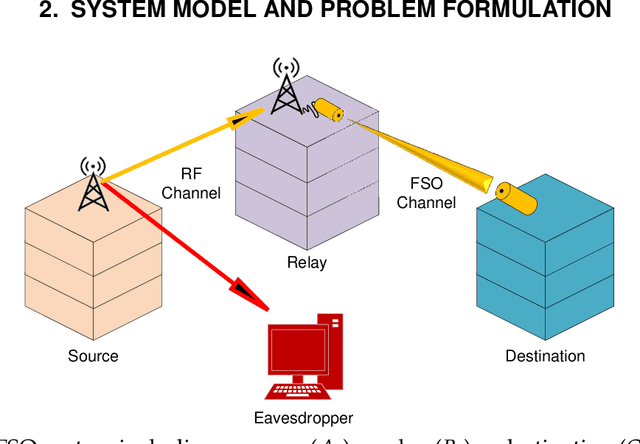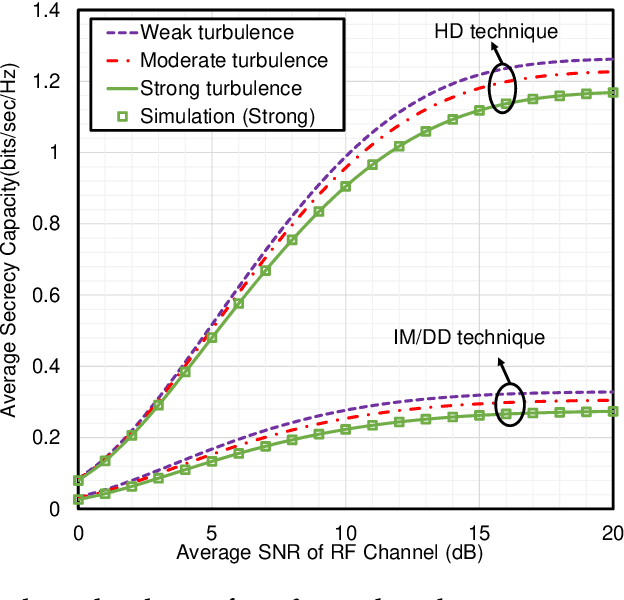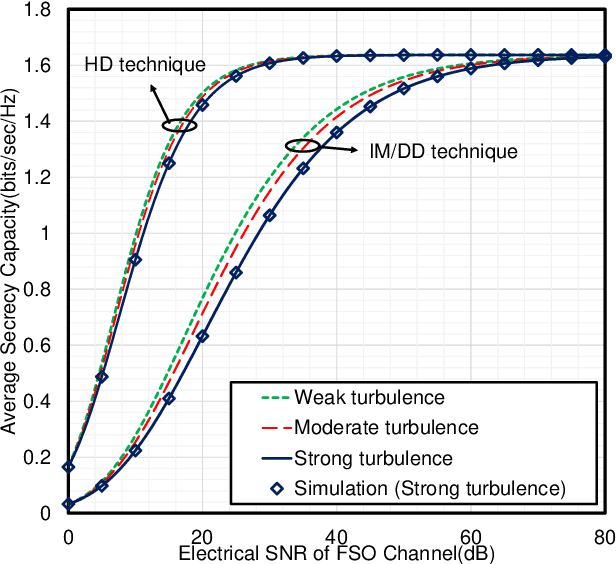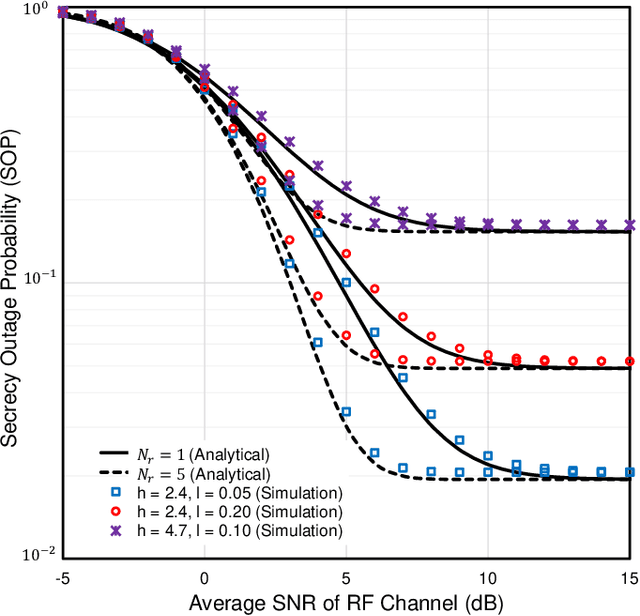Milton Kumar Kundu
Secrecy Outage Analysis of Energy Harvesting Relay-based Mixed UOWC-RF Network with Multiple Eavesdroppers
Feb 20, 2023Abstract:This work deals with the physical layer security performance of a dual-hop underwater optical communication (UOWC)-radio frequency (RF) network under the intruding attempts of multiple eavesdroppers via RF links. The intermediate decode and forward relay node between the underwater source and the destination transforms the optical signal into electrical form and re-transmits it to the destination node with the help of harvested energy by the relay from an integrated power beacon within the system. The source-to-relay link (UOWC) follows a mixture exponential generalized Gamma turbulence with pointing error impairments whereas all the remaining links (RF) undergo $\kappa-\mu$ shadowed fading. With regards to the types of intruders, herein two scenarios are considered, i.e., colluding (\textit{Scenario-I}) and non-colluding (\textit{Scenario-II}) eavesdroppers and the analytical expressions of secure outage probability, probability of strictly positive secrecy capacity, and effective secrecy throughput are derived in closed form for each scenario. Furthermore, the impacts of UOWC and RF channel parameters as well as detection techniques on secrecy capacity are demonstrated, and following this a comparison between the two considered scenarios is demonstrated that reveals the collusion between the eavesdroppers imposes the most harmful threat on secrecy throughput but a better secrecy level can be attained adopting diversity at the destination and power beacon nodes along with heterodyne detection rather than intensity modulation and direct detection technique. Finally, all the derived expressions are corroborated via Monte Carlo simulations.
Effects of Eavesdropper on the Performance of Mixed η-μ and DGG Cooperative Relaying System
Jun 13, 2021



Abstract:Free-space optical (FSO) channel offers line-of-sight wireless communication with high data rates and high secrecy utilizing unlicensed optical spectrum and also paves the way to the solution of the last-mile access problem. Since atmospheric turbulence is a hindrance to an enhanced secrecy performance, the mixed radio frequency (RF)-FSO system is gaining enormous research interest in recent days. But conventional FSO models except for the double generalized Gamma (DGG) model can not demonstrate secrecy performance for all ranges of turbulence severity. This reason has led us to propose a dual-hop eta-mu and unified DGG mixed RF-FSO network while considering eavesdropping at both RF and FSO hops. The security of these proposed scenarios is investigated in terms of two metrics, i.e., strictly positive secrecy capacity and secure outage probability. Exploiting these expressions, we further investigate how the secrecy performance is affected by various system parameters, i.e., fading, turbulence, and pointing errors. A demonstration is made between heterodyne detection (HD) and intensity modulation and direct detection (IM/DD) techniques while exhibiting superior secrecy performance for HD technique over IM/DD technique. Finally, all analytical results are corroborated via Monte-Carlo simulations.
On Secrecy Performance of Mixed α-η-μ and Malaga RF-FSO Variable Gain Relaying Channel
May 26, 2021



Abstract:With the completion of standardization of fifth-generation (5G) networks, the researchers have begun visioning sixth-generation (6G) networks that are predicted to be human-centric. Hence, similar to 5G networks, besides high data rate, providing secrecy and privacy will be the center of attention by the wireless research community. To support the visions beyond 5G (B5G) and 6G, in this paper we propose a secure radio frequency (RF)-free-space optical (FSO) mixed framework under the attempt of wiretapping by an eavesdropper at the RF hop. We assume the RF links undergo alpha-eta-mu fading whereas the FSO link exhibits a unified Malaga turbulence model with pointing error. The secrecy performance is evaluated by deducing expressions for three secrecy metrics i.e. average secrecy capacity, secure outage probability, and probability of non-zero secrecy capacity in terms of univariate and bivariate Meijer's G and Fox's H functions. We further capitalize on these expressions to demonstrate the impacts of fading, atmospheric turbulence, and pointing errors and show a comparison between two detection techniques (i.e. heterodyne detection (HD) and intensity modulation with direct detection (IM/DD)) that clearly reveals better secrecy can be achieved with HD technique relative to the IM/DD method. The inclusion of generalized fading models at the RF and FSO hops offers unification of several classical scenarios as special cases thereby exhibiting a more generic nature relative to the existing literature. Finally, all the analytical results are corroborated via Monte-Carlo simulations.
Enhancing Security of TAS/MRC Based Mixed RF-UOWC System with Induced Underwater Turbulence Effect
May 19, 2021



Abstract:Post commercial deployment of fifth-generation (5G) technologies, the consideration of sixth-generation (6G) networks is drawing remarkable attention from research communities. Researchers suggest that similar to 5G, 6G technology must be human-centric where high secrecy together with high data rate will be the key features. These challenges can be easily overcome utilizing PHY security techniques over high-frequency free-space or underwater optical wireless communication (UOWC) technologies. But in long-distance communication, turbulence components drastically affect the optical signals, leading to the invention of the combination of radio-frequency (RF) links with optical links. This work deals with the secrecy performance analysis of a mixed RF-UOWC system where an eavesdropper tries to intercept RF communications. RF and optical links undergo $\eta-\mu$ and mixture exponential generalized Gamma distributions, respectively. To keep pace with the high data rate of optical technologies, we exploit the antenna selection scheme at the source and maximal ratio combining diversity at the relay and eavesdropper, while the eavesdropper is unaware of the antenna selection scheme. We derive closed-form expressions of average secrecy capacity, secrecy outage probability, and strictly positive secrecy capacity to demonstrate the impacts of the system parameters on the secrecy behavior. Finally, the expressions are corroborated via Monte-Carlo simulations.
 Add to Chrome
Add to Chrome Add to Firefox
Add to Firefox Add to Edge
Add to Edge